Kaiyuan Li
VQL: An End-to-End Context-Aware Vector Quantization Attention for Ultra-Long User Behavior Modeling
Aug 23, 2025Abstract:In large-scale recommender systems, ultra-long user behavior sequences encode rich signals of evolving interests. Extending sequence length generally improves accuracy, but directly modeling such sequences in production is infeasible due to latency and memory constraints. Existing solutions fall into two categories: (1) top-k retrieval, which truncates the sequence and may discard most attention mass when L >> k; and (2) encoder-based compression, which preserves coverage but often over-compresses and fails to incorporate key context such as temporal gaps or target-aware signals. Neither class achieves a good balance of low-loss compression, context awareness, and efficiency. We propose VQL, a context-aware Vector Quantization Attention framework for ultra-long behavior modeling, with three innovations. (1) Key-only quantization: only attention keys are quantized, while values remain intact; we prove that softmax normalization yields an error bound independent of sequence length, and a codebook loss directly supervises quantization quality. This also enables L-free inference via offline caches. (2) Multi-scale quantization: attention heads are partitioned into groups, each with its own small codebook, which reduces quantization error while keeping cache size fixed. (3) Efficient context injection: static features (e.g., item category, modality) are directly integrated, and relative position is modeled via a separable temporal kernel. All context is injected without enlarging the codebook, so cached representations remain query-independent. Experiments on three large-scale datasets (KuaiRand-1K, KuaiRec, TMALL) show that VQL consistently outperforms strong baselines, achieving higher accuracy while reducing inference latency, establishing a new state of the art in balancing accuracy and efficiency for ultra-long sequence recommendation.
Balanced Token Pruning: Accelerating Vision Language Models Beyond Local Optimization
May 28, 2025Abstract:Large Vision-Language Models (LVLMs) have shown impressive performance across multi-modal tasks by encoding images into thousands of tokens. However, the large number of image tokens results in significant computational overhead, and the use of dynamic high-resolution inputs further increases this burden. Previous approaches have attempted to reduce the number of image tokens through token pruning, typically by selecting tokens based on attention scores or image token diversity. Through empirical studies, we observe that existing methods often overlook the joint impact of pruning on both the current layer's output (local) and the outputs of subsequent layers (global), leading to suboptimal pruning decisions. To address this challenge, we propose Balanced Token Pruning (BTP), a plug-and-play method for pruning vision tokens. Specifically, our method utilizes a small calibration set to divide the pruning process into multiple stages. In the early stages, our method emphasizes the impact of pruning on subsequent layers, whereas in the deeper stages, the focus shifts toward preserving the consistency of local outputs. Extensive experiments across various LVLMs demonstrate the broad effectiveness of our approach on multiple benchmarks. Our method achieves a 78% compression rate while preserving 96.7% of the original models' performance on average.
ImagineBench: Evaluating Reinforcement Learning with Large Language Model Rollouts
May 15, 2025Abstract:A central challenge in reinforcement learning (RL) is its dependence on extensive real-world interaction data to learn task-specific policies. While recent work demonstrates that large language models (LLMs) can mitigate this limitation by generating synthetic experience (noted as imaginary rollouts) for mastering novel tasks, progress in this emerging field is hindered due to the lack of a standard benchmark. To bridge this gap, we introduce ImagineBench, the first comprehensive benchmark for evaluating offline RL algorithms that leverage both real rollouts and LLM-imaginary rollouts. The key features of ImagineBench include: (1) datasets comprising environment-collected and LLM-imaginary rollouts; (2) diverse domains of environments covering locomotion, robotic manipulation, and navigation tasks; and (3) natural language task instructions with varying complexity levels to facilitate language-conditioned policy learning. Through systematic evaluation of state-of-the-art offline RL algorithms, we observe that simply applying existing offline RL algorithms leads to suboptimal performance on unseen tasks, achieving 35.44% success rate in hard tasks in contrast to 64.37% of method training on real rollouts for hard tasks. This result highlights the need for algorithm advancements to better leverage LLM-imaginary rollouts. Additionally, we identify key opportunities for future research: including better utilization of imaginary rollouts, fast online adaptation and continual learning, and extension to multi-modal tasks. Our code is publicly available at https://github.com/LAMDA-RL/ImagineBench.
BBQRec: Behavior-Bind Quantization for Multi-Modal Sequential Recommendation
Apr 09, 2025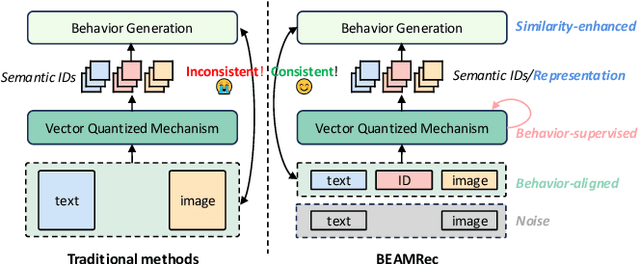
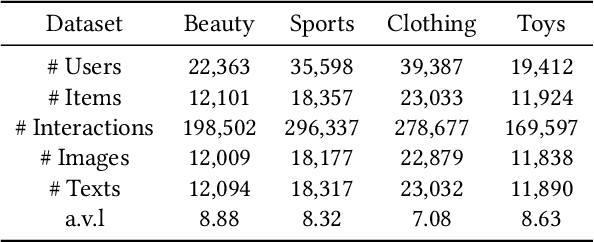
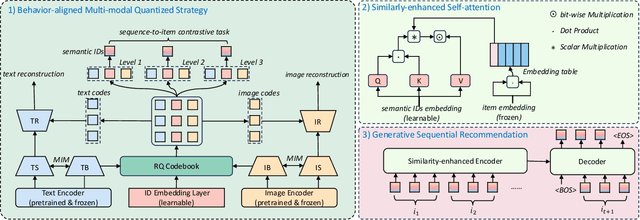
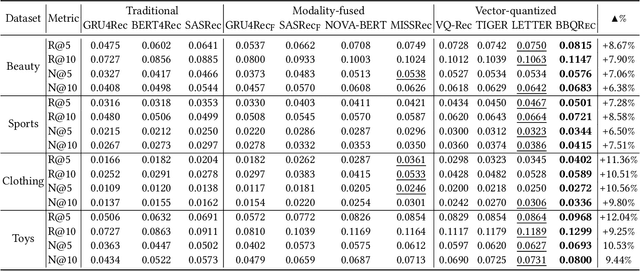
Abstract:Multi-modal sequential recommendation systems leverage auxiliary signals (e.g., text, images) to alleviate data sparsity in user-item interactions. While recent methods exploit large language models to encode modalities into discrete semantic IDs for autoregressive prediction, we identify two critical limitations: (1) Existing approaches adopt fragmented quantization, where modalities are independently mapped to semantic spaces misaligned with behavioral objectives, and (2) Over-reliance on semantic IDs disrupts inter-modal semantic coherence, thereby weakening the expressive power of multi-modal representations for modeling diverse user preferences. To address these challenges, we propose a Behavior-Bind multi-modal Quantization for Sequential Recommendation (BBQRec for short) featuring dual-aligned quantization and semantics-aware sequence modeling. First, our behavior-semantic alignment module disentangles modality-agnostic behavioral patterns from noisy modality-specific features through contrastive codebook learning, ensuring semantic IDs are inherently tied to recommendation tasks. Second, we design a discretized similarity reweighting mechanism that dynamically adjusts self-attention scores using quantized semantic relationships, preserving multi-modal synergies while avoiding invasive modifications to the sequence modeling architecture. Extensive evaluations across four real-world benchmarks demonstrate BBQRec's superiority over the state-of-the-art baselines.
CHIME: A Compressive Framework for Holistic Interest Modeling
Apr 09, 2025Abstract:Modeling holistic user interests is important for improving recommendation systems but is challenged by high computational cost and difficulty in handling diverse information with full behavior context. Existing search-based methods might lose critical signals during behavior selection. To overcome these limitations, we propose CHIME: A Compressive Framework for Holistic Interest Modeling. It uses adapted large language models to encode complete user behaviors with heterogeneous inputs. We introduce multi-granular contrastive learning objectives to capture both persistent and transient interest patterns and apply residual vector quantization to generate compact embeddings. CHIME demonstrates superior ranking performance across diverse datasets, establishing a robust solution for scalable holistic interest modeling in recommendation systems.
The Point, the Vision and the Text: Does Point Cloud Boost Spatial Reasoning of Large Language Models?
Apr 06, 2025Abstract:3D Large Language Models (LLMs) leveraging spatial information in point clouds for 3D spatial reasoning attract great attention. Despite some promising results, the role of point clouds in 3D spatial reasoning remains under-explored. In this work, we comprehensively evaluate and analyze these models to answer the research question: \textit{Does point cloud truly boost the spatial reasoning capacities of 3D LLMs?} We first evaluate the spatial reasoning capacity of LLMs with different input modalities by replacing the point cloud with the visual and text counterparts. We then propose a novel 3D QA (Question-answering) benchmark, ScanReQA, that comprehensively evaluates models' understanding of binary spatial relationships. Our findings reveal several critical insights: 1) LLMs without point input could even achieve competitive performance even in a zero-shot manner; 2) existing 3D LLMs struggle to comprehend the binary spatial relationships; 3) 3D LLMs exhibit limitations in exploiting the structural coordinates in point clouds for fine-grained spatial reasoning. We think these conclusions can help the next step of 3D LLMs and also offer insights for foundation models in other modalities. We release datasets and reproducible codes in the anonymous project page: https://3d-llm.xyz.
PLPHP: Per-Layer Per-Head Vision Token Pruning for Efficient Large Vision-Language Models
Feb 20, 2025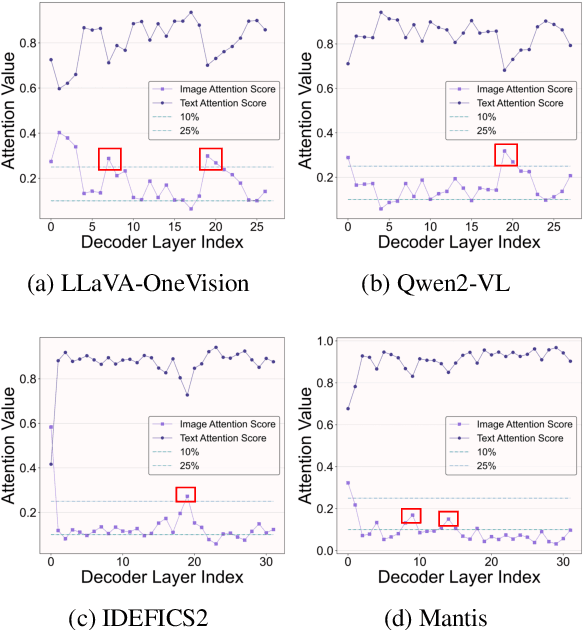
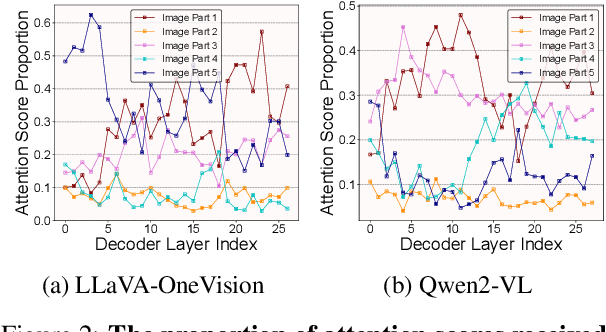

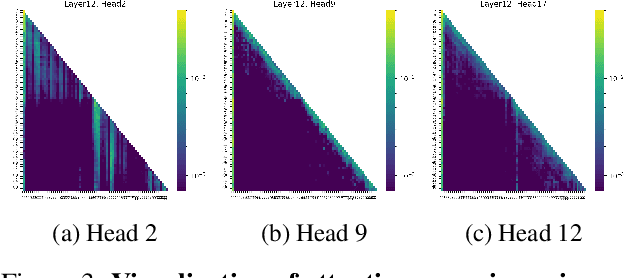
Abstract:Large Vision-Language Models (LVLMs) have demonstrated remarkable capabilities across a range of multimodal tasks. However, their inference efficiency is constrained by the large number of visual tokens processed during decoding. To address this challenge, we propose Per-Layer Per-Head Vision Token Pruning (PLPHP), a two-level fine-grained pruning method including Layer-Level Retention Rate Allocation and Head-Level Vision Token Pruning. Motivated by the Vision Token Re-attention phenomenon across decoder layers, we dynamically adjust token retention rates layer by layer. Layers that exhibit stronger attention to visual information preserve more vision tokens, while layers with lower vision attention are aggressively pruned. Furthermore, PLPHP applies pruning at the attention head level, enabling different heads within the same layer to independently retain critical context. Experiments on multiple benchmarks demonstrate that PLPHP delivers an 18% faster decoding speed and reduces the Key-Value Cache (KV Cache) size by over 50%, all at the cost of 0.46% average performance drop, while also achieving notable performance improvements in multi-image tasks. These results highlight the effectiveness of fine-grained token pruning and contribute to advancing the efficiency and scalability of LVLMs. Our source code will be made publicly available.
Understanding and Evaluating Hallucinations in 3D Visual Language Models
Feb 18, 2025Abstract:Recently, 3D-LLMs, which combine point-cloud encoders with large models, have been proposed to tackle complex tasks in embodied intelligence and scene understanding. In addition to showing promising results on 3D tasks, we found that they are significantly affected by hallucinations. For instance, they may generate objects that do not exist in the scene or produce incorrect relationships between objects. To investigate this issue, this work presents the first systematic study of hallucinations in 3D-LLMs. We begin by quickly evaluating hallucinations in several representative 3D-LLMs and reveal that they are all significantly affected by hallucinations. We then define hallucinations in 3D scenes and, through a detailed analysis of datasets, uncover the underlying causes of these hallucinations. We find three main causes: (1) Uneven frequency distribution of objects in the dataset. (2) Strong correlations between objects. (3) Limited diversity in object attributes. Additionally, we propose new evaluation metrics for hallucinations, including Random Point Cloud Pair and Opposite Question Evaluations, to assess whether the model generates responses based on visual information and aligns it with the text's meaning.
CropCraft: Inverse Procedural Modeling for 3D Reconstruction of Crop Plants
Nov 14, 2024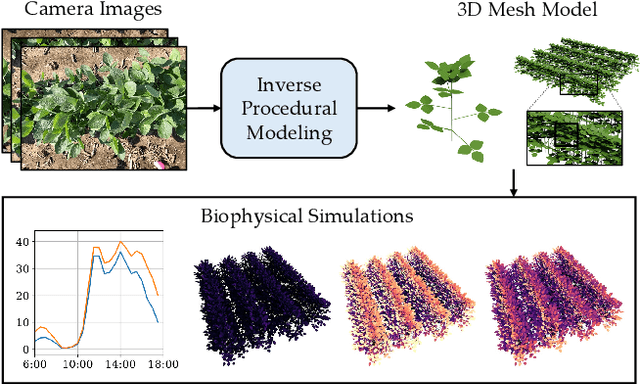

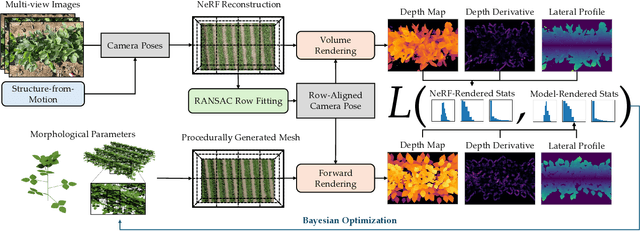

Abstract:The ability to automatically build 3D digital twins of plants from images has countless applications in agriculture, environmental science, robotics, and other fields. However, current 3D reconstruction methods fail to recover complete shapes of plants due to heavy occlusion and complex geometries. In this work, we present a novel method for 3D reconstruction of agricultural crops based on optimizing a parametric model of plant morphology via inverse procedural modeling. Our method first estimates depth maps by fitting a neural radiance field and then employs Bayesian optimization to estimate plant morphological parameters that result in consistent depth renderings. The resulting 3D model is complete and biologically plausible. We validate our method on a dataset of real images of agricultural fields, and demonstrate that the reconstructions can be used for a variety of monitoring and simulation applications.
WHALE: Towards Generalizable and Scalable World Models for Embodied Decision-making
Nov 08, 2024



Abstract:World models play a crucial role in decision-making within embodied environments, enabling cost-free explorations that would otherwise be expensive in the real world. To facilitate effective decision-making, world models must be equipped with strong generalizability to support faithful imagination in out-of-distribution (OOD) regions and provide reliable uncertainty estimation to assess the credibility of the simulated experiences, both of which present significant challenges for prior scalable approaches. This paper introduces WHALE, a framework for learning generalizable world models, consisting of two key techniques: behavior-conditioning and retracing-rollout. Behavior-conditioning addresses the policy distribution shift, one of the primary sources of the world model generalization error, while retracing-rollout enables efficient uncertainty estimation without the necessity of model ensembles. These techniques are universal and can be combined with any neural network architecture for world model learning. Incorporating these two techniques, we present Whale-ST, a scalable spatial-temporal transformer-based world model with enhanced generalizability. We demonstrate the superiority of Whale-ST in simulation tasks by evaluating both value estimation accuracy and video generation fidelity. Additionally, we examine the effectiveness of our uncertainty estimation technique, which enhances model-based policy optimization in fully offline scenarios. Furthermore, we propose Whale-X, a 414M parameter world model trained on 970K trajectories from Open X-Embodiment datasets. We show that Whale-X exhibits promising scalability and strong generalizability in real-world manipulation scenarios using minimal demonstrations.
 Add to Chrome
Add to Chrome Add to Firefox
Add to Firefox Add to Edge
Add to Edge